
The "Burdick Print"
Copyright © 1989-2007 by Glen J. Kuban and Gregg Wilkerson
![]()

The "Burdick Print"
Copyright © 1989-2007 by Glen J. Kuban and Gregg Wilkerson
![]()
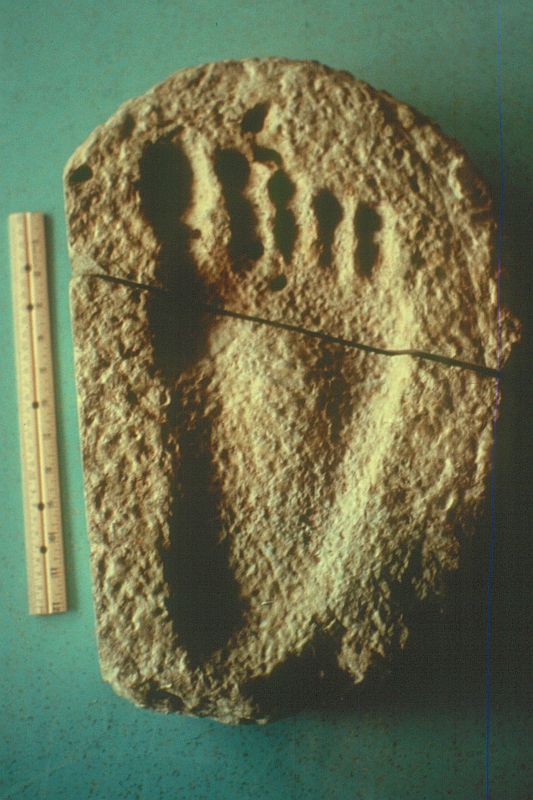
|
| Figure 1. The Burdick Print. An alleged "giant man track" from Glen Rose, Texas, showing severe anatomic errors and subsurface features indicating a carved origin. Evidence indicates it was carved by local resident George Adams during the 1930's. (C) 1986, Glen J. Kuban |
Abstract
The Burdick Print (or Burdick Track) is claimed by some creationists to be a "giant man track" from Glen Rose, Texas. However, it is one of several prints on loose blocks of rock which show strong evidence of a carved origin, and is acknowledged by Glen Rose residents to be one of the carvings made by George Adams in the 1930's. It shows serious anatomic errors as well as subsurface features which truncate at the print's surface, confirming it's carved origin. Furthermore, the orientation of algal fossils in the rock suggests that the original "up" direction was the side opposite the alleged footprint. In other words, evidently the carver unwittingly created the print on what was originally the bottom side of the rock.
Introduction
Many creationists once claimed that fossilized human footprints or "man tracks" occurred alongside dinosaur tracks in Paluxy Riverbed near Glen Rose, Texas, supposedly refuting evolution and the standard geologic timetable. However, careful investigations of the Paluxy evidence in recent years have shown that the alleged human prints involved a variety of misidentified phenomena, including metatarsal dinosaur tracks, erosional markings, and a smaller number of doctored and carved specimens--most of the latter on loose blocks of rock (Cole and Godfrey 1985; Kuban 1986a, 1986b, 1986c, 1989; Hastings 1987, 1988; Strahler, 1989).
In the wake of these developments most creationists have largely abandoned the "man track" claims, although a few persistent individuals continue to promote them, including Carl Baugh and Don Patton. This paper focuses on a loose rock slab called the "Burdick Print," which Baugh and Patton claim to be genuine giant human footprint (Patton, 1990), but which is shown to be a carving by several lines of evidence.
History
Several known loose "man tracks" are reported to have come from Glen Rose, Texas, or nearby areas. Four of the slabs are strikingly similar in appearance: all having long toes, very wide ball, and other abnormal features, possibly indicating a common carver. At least three such "long-toed" slabs still exist, including the "Burdick track" and two slabs that led paleontologist Roland Bird to Glen Rose in 1938 (discussed below). A fourth long-toed slab is known only from a photograph. Yet another slab, often called the "Caldwell track," has a very different appearance (with short toes and narrower ball); although still promoted by Carl Baugh and a few others, it was shown to be a definite carving years ago (Neufeld, 1975).
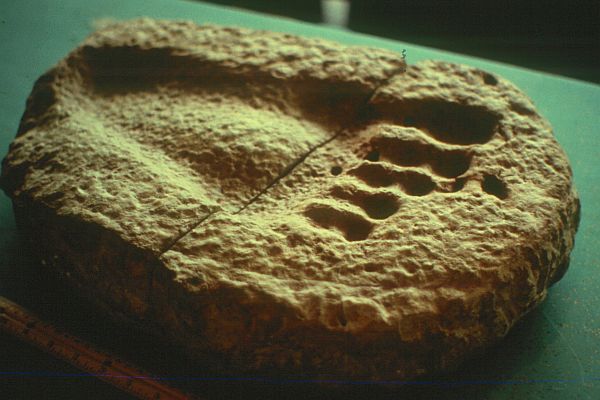
|
| Figure 2. The Burdick Print (side view). (C) 1986, Glen J. Kuban |
Two of the "long toed slabs" were first publicized after being seen by Roland T. Bird in a trading post near Gallup, New Mexico in 1938. Bird immediately recognized the tracks as carvings, but wondered what prompted someone to make them. His curiosity was further piqued upon seeing four dinosaur track carvings in a nearby shop. After learning the tracks reportedly came from Glen Rose, Bird redirected his travel route to that location, leading to his now famous dinosaur track excavations there (Bird 1939, 1954).
While in Glen Rose Bird asked about the "man tracks" but the only specimen the locals were able to show him was a single, indistinct elongate depression, which Bird speculated was made by an unknown dinosaur. Evidently Bird was on the right track, so to speak, since it is now known that elongate (metatarsal) dinosaur tracks are common in the area, and have often been mistaken by locals and creationists for "man tracks" (Kuban, 1986b). Such tracks may have initiated the first "man track" rumors among local residents in the early 1900's, and perhaps inspired the early "man track" carvings (along with economic need during the Great Depression).
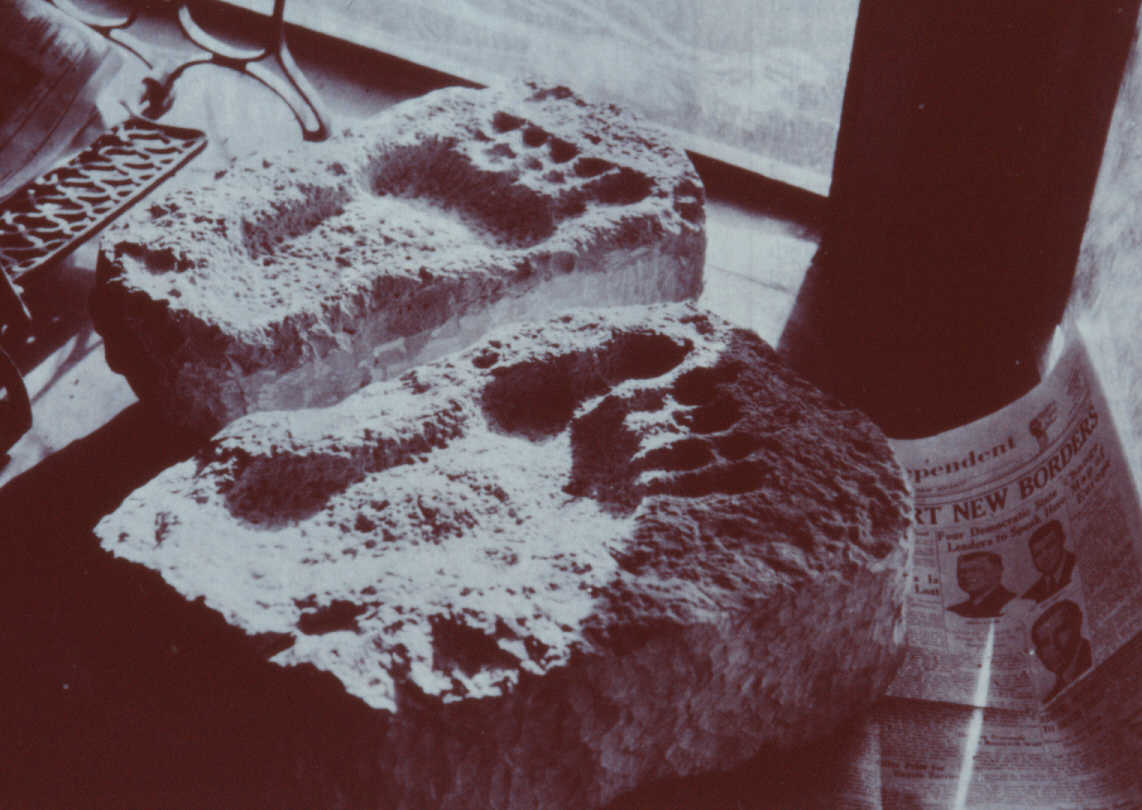 |
| Figure 2b.
Carved "man tracks" spotted by Roland Bird in 1938, in
a trading post window in New Mexico. |
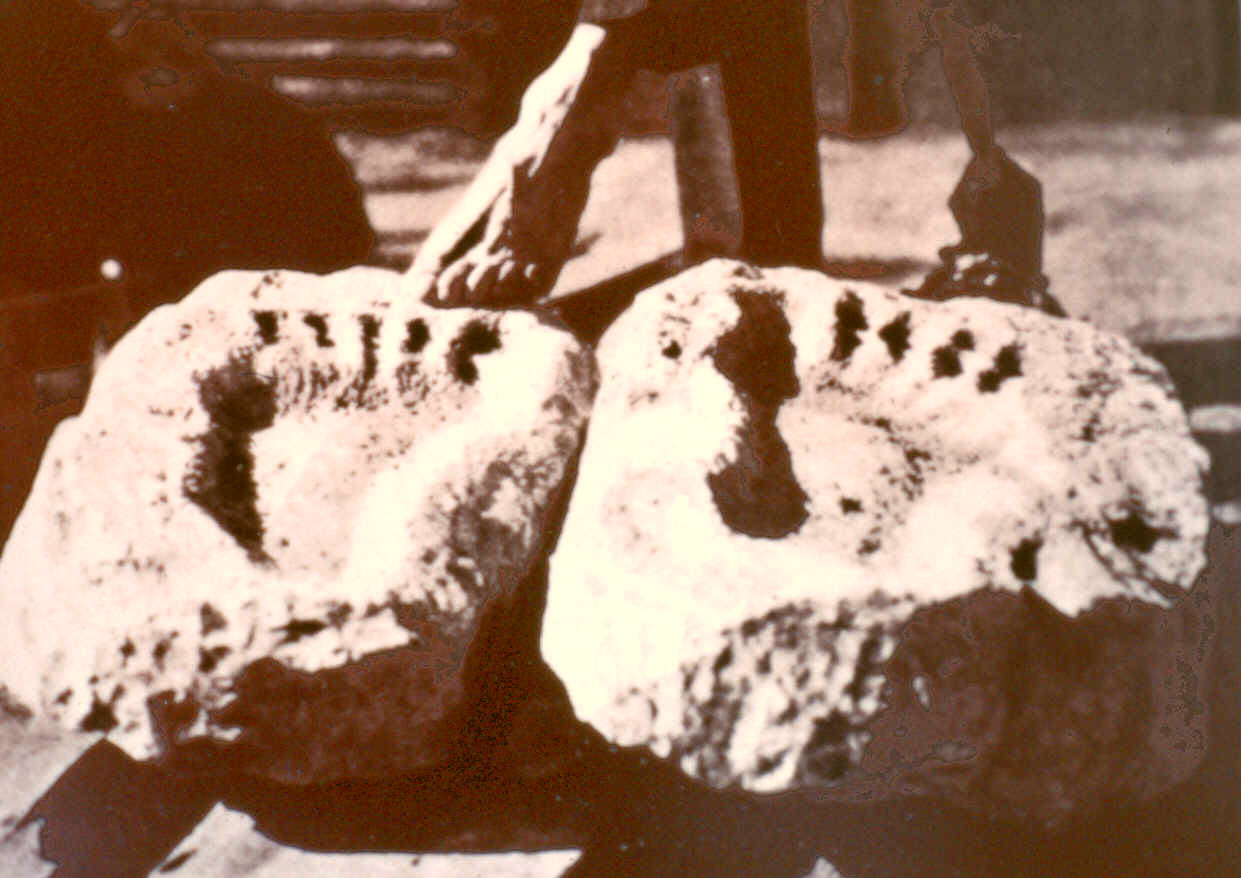 |
| Figure 2c. The "Gallup Slabs" as pictured in The Genesis Flood. Photo courtesy of Clifford Burdick |
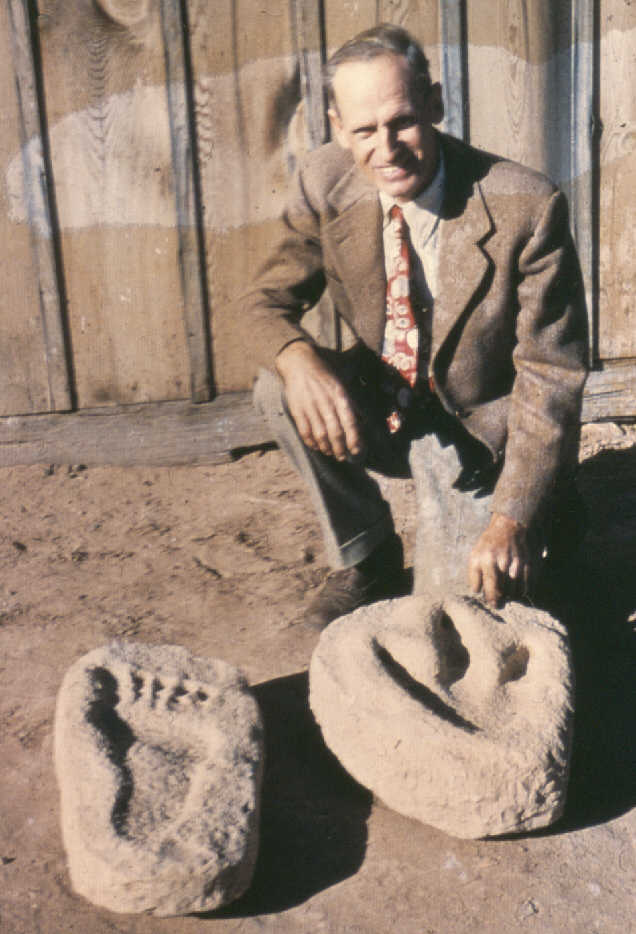 |
| Figure 2d
Clifford Burdick with the Gallup "right" slab and
a carved dinosaur track. Photo courtesy of C. Burdick |
In 1939 Bird described his work at Glen Rose in Natural History magazine, mentioning the loose "man track" slabs he has seen in Gallup and the single elongate "mystery" track, neither of which he considered genuine human tracks. However, a completely different impression was soon fostered by some creationists.
In 1950 and 1955 Burdick published articles in The Signs of the Times claiming that clear human tracks exist in the Paluxy Riverbed. Rather than showing photographs of "man tracks" in the riverbed itself, the only Glen Rose "man tracks" Burdick pictured the two loose slabs Bird had seen in New Mexico. Burdick implied that the pictured slabs were examples of genuine "man tracks" that Bird had seen in the riverbed and removed from it, which was not the case.
Other "man track" claims based on the same loose slabs were made by John C. Whitcomb and Henry M. Morris in the popular creationist book The Genesis Flood (1961). The authors implied that the pictured Gallup slabs were perfectly natural in appearance and known to be genuine tracks chiseled out of the Paluxy. Likewise, creationist A.E. Wilder-Smith failed to distinguish between the loose slabs and the alleged human tracks in the riverbed, and even implied that Bird had cut out clear human tracks.(1968, 1975). Later, other creationists (including John Morris, Henry Morris' son) were more skeptical of these and other loose "man tracks," and instead focused on supposed in situ human tracks in the Paluxy riverbed.
Where the Gallup slabs came from before Roland Bird saw them in New Mexico is uncertain, but some sketchy information exists. According to John Morris, Burdick's early investigations in the 1940's led him to Al Berry, who was in possession of these and other track slabs. Berry signed an affidavit stating that he and his friend Jack Hill (who owned the store where Bird saw the Gallup slabs) went to Glen Rose in September of 1938 to retrieve some "human" and "cat" tracks which were in danger of being destroyed by the construction of a small dam on the Paluxy river. However, there is reason to believe that if these tracks were present in the riverbed, they may have been carved there before Berry and Hill arrived--perhaps by George Adams. This conclusion was supported by Robert Gentry, who once believed the prints genuine, but later changed his mind based on some unspecified information that came to him (Morris, 1980, p. 115). It is also possible that the tracks were never in the riverbed, but carved on loose blocks from the start. In any case, there is no in situ documentation for these tracks, which immediately compromises their scientific value.

|
| Figure 3.The Burdick Slabs. At right is the "Burdick Print" before cross sectioning. At left is a similar carving whose whereabouts is unknown. Another pair of loose "giant tracks" with similar artistic style (but on more rectangular blocks of rock) led paleontologist Roland T. Bird to Glen Rose in 1938. Photograph by Clifford Burdick, c. 1950. |
According to John Morris, the Burdick track (the right-foot slab) was purchased "years ago" by Burdick from a Rev. Beddoe of Arizona, who in turn had purchased the track from the late Pessee Hudson, proprietor of a knick- knack store in Glen Rose. Morris added that "many things were purchased in that store, including some of George Adams carvings." Morris continued, "tracing the print proved impossible, but it was reported to have come from a tributary south of Glen Rose." (1980, p. 117). More recently Carl Baugh and Don Patton claim that based on clues from "old timers" in Glen Rose, and comparison of matrix features, they traced the source of the Burdick Track to the Cross Branch of the Paluxy. However, they did not provide any documentation of the lithologic match, nor evidence that rocks from other tributaries or outcrops around Glen Rose would not have matched. Neither did they report finding any evidence of a trackway there from which the Burdick Print would have came, nor evidence that the Cross Branch contained any other tracks (human or otherwise).
Morris was equivocal about the authenticity of the Burdick track. His analysis listed several supposedly positive aspects about the track (none of which are valid, as discussed further below). He also neglected several serious problems with the print. However, Morris acknowledged that it might have been carved, and that it is considered a carving by most researchers (1980, p. 118).
During the 1970's most other creationists also questioned or rejected this print and other loose track slabs. In the early 1970's Stanley Taylor and crew investigated several Paluxy sites and promoted various "man track" claims in articles and their widely viewed film Footprints in Stone (1973), but acknowledged that the loose slabs were probable carvings. In 1970 the Loma Linda team cross sectioned the Burdick track across the ball; although the team considered the subsurface features ambiguous, they concluded that the track was a probable carving, based on its external features and the knowledge that similar tracks were carved in Glen Rose. They also sectioned one of the Gallup slabs and a "cat" slab, both of which they found to be probable carvings; and the Caldwell track, which they concluded to be a definite carving (Neufeld, 1975). In the 1980's the anatomical problems with the loose slabs were further elucidated by mainstream workers (Cole et al, 1985).
Around 1983 the Burdick track was acquired from Burdick by Carl E. Baugh, who began excavating and promoting alleged "man tracks" in Glen Rose in 1982. Baugh regularly displays the Burdick track in his Creation Evidences Museum, and prominently featured it in his table display at the 1986 International Creation Conference (ICC) in Pittsburgh, Pa., where I was allowed to inspect and photograph the slab.
 |
| Figure 2b.
Burdick Track showing new cuts made through toe and
heel areas in 1990 (photo link to CEM website). |
In 1990 the Burdick track was re-sectioned across the toes and heel under the direction of Carl Baugh and Don Patton. Subsequently Patton promoted the track in the MIOS newsletter, which requested donations for a new museum display of the track (Patton, 1990). At the 2nd International Conference on Creationism in 1990, Patton displayed and sold photographs of the new cross sections, claiming that they showed subsurface deformation lines proving the print authentic. However, others at the conference, including the current authors and creationist paleontologist Kurt Wise, observed that the alleged pressure features were algal structures truncated by the print depression, indicating that that track was carved. Nevertheless, Carl Baugh and Don Patton continued to promote the track as genuine (Baugh, 1996, 2005).
Print Morphology
The Burdick track is on a tan limestone slab about 18 inches long by 13 inches wide by about 5 inches thick. The print depression itself is "giant sized," approximately 15 inches (38 cm) long by 7 1/2 (19 cm) inches wide (across the ball). It is about an inch deep at the deepest parts (the ball and big toe).
The general shape of the print depression is not that of a genuine human print. The track boundaries and features are distinct (eliminating the possibility that abnormalities are due to slippage, turning, or mud-slumping), but not anatomically correct. The length of the print alone is not necessarily an objection, since such foot lengths are occasionally encountered. However, the track proportions and other features are very abnormal, even for a 15 inch foot.
The print is too wide at the "ball" and too narrow at the heel, giving the print an almost triangular shape overall. The length to ball-width ratio is about 2.0, compared to a typical range of 2.4 to 2.8 for normal, clear human tracks.
The toes depressions are far too long, and the "big toe" is too narrow. The lengths of outermost two toes are especially abnormal, being nearly twice the expected lengths. Also, all four lessor toes show peculiar, multiple joint or pad marks. On a normal print the lesser toes normally register as mere dots. Don Patton suggested that the shape of the toes was due to "turning," but the print shows no indication of lateral foot movement, and a normal foot would not produce toe marks of this shape even if the foot had turned. As anthropologist Laurie Godfrey observed while discussing the long toed slabs, it looks as if a carver was looking at the top of his foot rather than at the bottom while making the toes (Godfrey, 1985).
Another problem is that a line drawn across the top of the toes would form an almost diagonal straight line, in contrast to the normally prominent downward curve from the big to the smallest.
Burdick and a few others have suggested that a raised ridge between the first two toes supported the authenticity of the print and would be "almost impossible to carve." Actually this feature would be easy to carve--requiring merely the reduction of the surrounding material (even that would be unnecessary if the original rock happened to have a raised area here).
Missing from the track is a raised transverse ridge that normally separates the ball from the toes. The ball itself is too straight across the top, too wide latitudinally, too far forward (especially at the center). The latter abnormality relates to another problem: a prominent mound near the center of the print (which intrudes into the ball). This mound evidently was intended to be an arch, but is misplaced and malproportioned (it should be closer to the inner edge). This misplacement creates an unnatural trench near the inner edge. The heel is too narrow and angled toward the rear; a normal print has a more prominent, distinctly ovoid heel depression.
One might object that the print proportions of a "giant" individual might be slightly different from those of a normal-sized person. Unfortunately for the "man track" advocates, to the extent that the print proportions would vary, they would do so in a manner opposite the pattern seen in the Burdick print and similar long-toed slabs. For example, the great toes of "giant" individuals would tend to be relatively wide and short. As Laurie Godfrey noted, the carver "not only did a poor job of reproducing the shape of a human footprint, but they erred in the wrong direction" (1985, pp. 20-21).
Don Patton has claimed that Dallas "James Donaldson," a Dallas "football player" has a foot over 3 inches longer than the Burdick track (making his foot over 18 inches long!) Evidently Patton meant James Donalson, a Dallas Mavericks basketball player, who wears a size 18 shoe (which translates to a foot about 13 1/4 inches--almost 2 inches smaller than the Burdick print). Patton also claimed, based on a recent Natural History article (1990), that certain Indian tracks have almost the same length/width ration as the Burdick print. However, this applies only to the foot-length/toe-width ratio (since these Indians have well splayed toes). The more important and static foot- length to ball-width ratio for the Indian tracks is about 2.6, which is normal for human tracks. Moreover, the overall shape of the Indian prints is clearly human, and differs in significant ways from the Burdick print.
Other External Features
The surface of the Burdick track contains many small pit marks unlike known track surfaces in Glen Rose. The sides of the slab show many chisel marks, which like the pit-marks, are reminiscent of the carving technique described by Wayland Adams. Don Patton (1990) claims to have found the outcrop from which the Burdick track was taken, but has not documented that the bed contains any tracks, or that it contains pit patterns like the Burdick track.
The upper right area of the slab contains a curved incision which John Morris suggests is a "circle" suggesting that the removed of the track began to chisel at this point but then decided to widen the circle to reduce the chance of damage. However, the incision is not a circle or anything close to it, and alternate explanations are equally plausible. A carver may have decided to trim the block down (either before or after carving) at the point of the incision, and then changed his mind. Some larger holes (near the toes) and some slash-like marks (mostly in the heel) also occur on the Burdick track. They have been claimed by some to be evidence of authenticity, on the assumption that carving would erase them (Morris, 1980, p. 121). However, the holes may be invertebrate burrows, and may well have been deep enough to survive carving. The slash-like marks may be remnants of chiseling. None of the marks constitute evidence of genuineness.
The print margins are largely flat and lacking in "mud up-push" features, which are usually, though not always, found on real tracks. There is a small raised area at the back of the heel, but this could be carved by reduction of material behind it, or due to a natural irregularity of the original rock slab.
Cross Sections
During the 1970's the track was sectioned longitudinally near the left edge, and diagonally through the ball. In 1990 the track was sectioned twice across the toes, and once through the heel. These five sections would expose 10 surfaces.
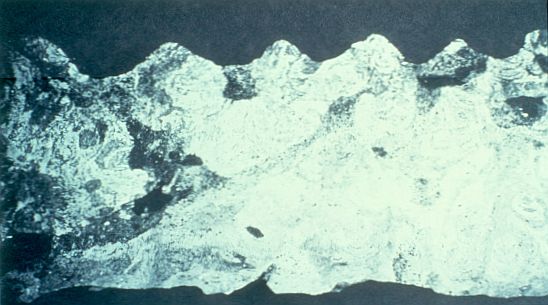
|
| Figure 4. Cross section through the toe area of the Burdick Print. |
Both surfaces of the ball section and one of the longitudinal surfaces (on the track side) were inspected and photographed by one of us (Kuban) at the ICC in 1986. Photographs of some of several recently exposed surfaces were examined by both authors at the 1990 ICC in Pittsburgh. One of us (Wilkerson) requested from MIOS permission to examine photographs of the remaining surfaces, and was denied. The inspected sections show elongated semi-circular stromatolite (algal) structures. Some of the algal structures happen to partially overlap some the toe depressions, prompting Patton to claim that the structures are pressure lines. However, the structures are distributed through much of the subsurface without regard to the location of the toe marks or other print depressions. Further, wherever the structures meet the print depression, they are truncated by the depression and/or not in proper coincidence with it. The nature of these structures is further described below.
Algal Structures
Although it is uncertain exactly where the slab on which the Burdick print originated, its general composition is typical of various limestone beds in the Glen Rose area. Moreover, one can deduce from certain algal features that the slab was already detached from its host formation when the print was carved. Indeed, as will be explained further below, the algal features seem to indicate that the "print" occurs on what was originally the underside of the original slab--providing still further evidence of carving.
Limestones are often formed by calcium secreting algae. Algal limestones are distinguished from other types of limestones by their characteristic small-scale stromatolite structure. The algal colonies grow upward in concentric layers that have a tear drop shape. The narrow end of the tear drops point downward. This orientation can be used to deduce the "up" direction in the rock.
Many stromatolites from 1/4 to 3/4 inch in diameter are seen in the cross sections of the Burdick track. The truncation of these structures at the bottom edges of the "print" indicates that complete structures once existed, but have been partly removed. The stromatolite morphology, with upward rather than downward curvature, indicates that the sedimentological "up" direction of the rock slab is opposite the "up" direction of the print; in other words, the print was probably carved on the bottom of the slab.
Coloration
Some of the stromatolitic structures have red-yellow discoloration. Algal organisms act as a mechanical trap for iron (magnetite) and other metals. They also act as an agent for chemical precipitation of metals because they provide the necessary reducing environment. Minute amounts of iron, upon oxidization and/or hydration form hematite and limonite, red and yellow-colored minerals respectively. These colorations are formed by the action of oxygenated ground waters subsequent to deposition and have nothing to do with formation or preservation of the track.
Requirements of Authenticity and a Prediction
Not all prints will show subsurface striations (depending on the nature of the host sediment). However, any bedding lines in the substrate should be consistently deformed by the track indentations, and should be similar for all the individual toe depressions. This clearly is not the case with the Burdick track. Besides showing poor consistency with the track depressions in general, there are dramatic differences in the features (or nonfeatures) under each of the toes.
If the track were authentic another necessary condition would be that any deformational lines seen in one section should be well matched by a nearby section. If, on the other hand, the alleged deformational lines are really stromatolite structures, one would not see the same relationship to the track indentations as in the displayed section. Specifically, since the stromatolite structures are generally semi-spherical, their individual axes would be significantly offset in the other section. This prediction could be tested by examination of the other toe section, which MIOS has not made public. Baugh and Patton have sold and published photographs only of those sections that they considered helpful to their case. They have been selective in their use of data and have not made the entire data set available to other researchers.
Conclusion
The Burdick track contains severe anatomic errors as well as abruptly truncated subsurface algal structures, indicating that it is a carving. The carver probably took a piece of limestone from a local outcrop, and carved a print (or enhanced an existing vague depression) on what was originally the "bottom" of the rock. The knowledge that similar tracks were carved in Glen Rose, and lack of in situ documentation for the track, further undermine claims that the track is genuine. Creationists would do well to abandon the Burdick track as anti-evolutionary evidence.
Editor's Note
Don Patton of MIOS was invited to submit a companion paper giving his interpretation of the Burdick tract, but declined.
References
Baugh, Carl E., 1982, Enemies Survived Together for A While (video Tape), Creation Evidences Museum, Glen Rose, TX.
Baugh, Carl E., 1987, Dinosaur, Promise Publishing, Orange, CA.
Baugh, Carl E., 1996, 2005, "The Burdick Track" (article at Baugh's Creation Evidence Museum website)
Beierle, Fred, 1977, Man, Dinosaurs, and History, Prosser, WA: Perfect Printing Co.
Bird, Roland T., 1939, "Thunder in His Footsteps," Natural History, Vol. 43, No. 5, pp. 254-261.
Bird, Roland T., 1985 (posthumous), Bones For Barnum Brown, edited by Theodore T. Schreiber, annotated by James O. Farlow. Ft. Worth, TX., TCU Press, pp. 214-216.
Burdick, Clifford C., "When Giants Roamed the Earth," Signs of the Times, July 25, 1950.
Cole, John R., and Laurie R. Godfrey, eds., 1985, Creation/Evolution, Issue 15, Vol. 5, No. 1, pp. 16-21
Dougherty, Cecil N., 1979 (sixth edition), Valley of the Giants, Bennett printing Company, Cleburne, TX.
Farlow, James O., 1987, Lower Cretaceous Dinosaur Tracks, Paluxy River Valley, Texas, SCGSA, Waco, Tx.
Godfrey, Laurie R., 1985, Foot Notes of An Anatomist, Creation/Evolution, Issue XV, Vol. 5, No. 1, pp. 16-21.
Godfrey, Laurie R., and John R. Cole, "Blunder in Their Footsteps," Natural History, Aug. 1986, Vol. 95, No. 8, pp. 4-12.
Hastings, 1986, Tracking Those Incredible Creationists: The Trail Continues, Creation/Evolution, Issue XVII, pp. 19-27.
Hastings, Ronnie J., 1987, Creationists' "Glen Rose Man" Proves to be a Fish Tooth (as Expected), NCSE Reports, Vol. 9, No. 3, pp. 14-15.
Hastings, 1987, Tracking Those Incredible Creationists: The Trail Goes On, Creation/Evolution, Issue XXI, pp. 30- 42.
Hastings, Ronnie J., 1987, New Observations on Paluxy Tracks Confirm Their Dinosaurian Origin, Journal of Geological Education, Vol. 35, No. 1, pp. 4-15.
Hastings, Ronnie J., 1988, Rise and Fall of the Paluxy Man Tracks, Perspectives on Science and Christian Faith (Journal of the ASA), Vol. 40, No. 3, pp. 144-155.
Kuban, Glen, 1986a, The Taylor Site "Man Tracks," Origins, Vol. 9, No. 1, pp. 1-9.
Kuban, Glen, 1986b, Elongate Dinosaur Tracks, in: Gillette, David D. and Martin G. Lockley, eds., Dinosaur Tracks and Traces, 1989, Cambridge University Press, Cambridge, pp. 57-72.
Kuban, Glen, 1986c, Color Distinctions and Other Curious Features of Dinosaur Tracks Near Glen Rose, Texas, in: Gillette, David D. and Martin G. Lockley, eds., Dinosaur Tracks and Traces, 1989, Cambridge University Press, Cambridge, pp. 427-440.
Kuban, Glen J., 1989, A Matter of Degree: An Examination of Carl Baugh's Credentials, NCSE Reports, Vol. 9, No. 6, pp. 15-20.
Kuban, Glen J., 1989, Retracking Those Incredible Man Tracks, NCSE Reports, Vol. 9, No. 4, Special Section.
Morris, John D., 1980, Tracking Those Incredible Dinosaurs and the People Who Knew Them, San Diego, CA., Creation-Life Publishers.
Morris, Henry M., and John C. Whitcomb, 1961, The Genesis Flood, Baker Book House: Grand Rapids, MI, pp. 173-175.
Neufeld, Berney, 1975, "Dinosaur Tracks and Giant Men", Origins, Vol. 2, No. 2, pp. 64-76.
Patton, Don, 1990, The Burdick Track Vindicated!, Dino Trax (newsletter of MIOS, the Metroplex Institute of Origins Science), Vol. 6, June. Patton claims that the rock bed from which the Burdick track came was the Cross Branch of the Paluxy.
Shrahler, Arthur, 1989, Science and Earth History, Prometheus Books.
Taylor, Stanley E., 1968, Search for Man Tracks in the Paluxy River, Films for Christ Special Report, October.
Taylor, Stanley E., 1971, The Mystery Tracks in Dinosaur Valley, Bible-Science Newsletter, Vol. 9, No. 4, pp. 1-7;
Taylor, Stanley E., 1973, Footprints in Stone (film), Films for Christ Association (Eden Films), Elmwood, IL (now Mesa, AZ).
Tuttle, Russell H., The Pitted Pattern of Laetoli Feet, Natural History, March, 1990, pp. 61-65.
Wilder-Smith, A. E., 1975, Man's Origin Man's Destiny, Harold Shaw Publishers, Wheaton, Il, pp. 293-298. (1st English version in 1968).

Home Page |
Browse |
Search |
Feedback |
Links
The FAQ |
Must-Read Files |
Index |
Creationism |
Evolution |
Age of the Earth |
Flood Geology |
Catastrophism |
Debates